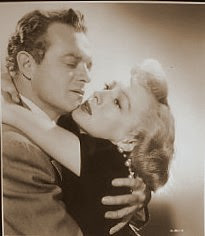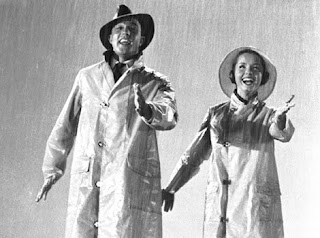 "August 15, 1944: the first American GIs came marching in, along the road to Grasse, friendly, relaxed, and smiling. They were distributing Hershey bars to the children who were lining the road, giggling, waving, and crying out whatever English exclamation they had heard, such as “Hi!” and “Hello!” and shouting “Bonjour! Les Américains!” The women cried, “Bravo! Vive les Américains!” and threw flowers, kissing the boys as they trooped along. I smiled, thinking, I must always remember this. The enormous dark lead weight had lifted from our lives after four years of distress and shame. The war was over".
"August 15, 1944: the first American GIs came marching in, along the road to Grasse, friendly, relaxed, and smiling. They were distributing Hershey bars to the children who were lining the road, giggling, waving, and crying out whatever English exclamation they had heard, such as “Hi!” and “Hello!” and shouting “Bonjour! Les Américains!” The women cried, “Bravo! Vive les Américains!” and threw flowers, kissing the boys as they trooped along. I smiled, thinking, I must always remember this. The enormous dark lead weight had lifted from our lives after four years of distress and shame. The war was over". "At fourteen I entered the national ballet school, Le Conservatoire, and did quite well. I also took classes with the great Russian teacher Alexandre Volinine, a gentle and charming man in his seventies who had been partner to Anna Pavlova. But I found it hard to withstand the pace of this heavy schedule and became anemic. I now started going to Madame Rozanne’s class, back at the Studio Wacker. The Ballets des Champs-Élysées confirmed the resurrection of Paris. Its home was the most prestigious of all the Paris theaters, Le Théâtre des Champs-Élysées, built in 1913 by August Perret in the purest art deco style".
"At fourteen I entered the national ballet school, Le Conservatoire, and did quite well. I also took classes with the great Russian teacher Alexandre Volinine, a gentle and charming man in his seventies who had been partner to Anna Pavlova. But I found it hard to withstand the pace of this heavy schedule and became anemic. I now started going to Madame Rozanne’s class, back at the Studio Wacker. The Ballets des Champs-Élysées confirmed the resurrection of Paris. Its home was the most prestigious of all the Paris theaters, Le Théâtre des Champs-Élysées, built in 1913 by August Perret in the purest art deco style".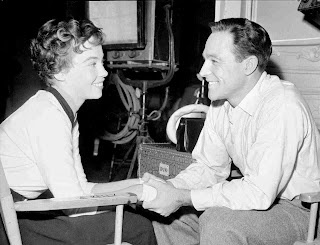 "MGM decided to hire me, after the test that Gene Kelly had shot with me some two or three weeks earlier. Gene had seen me dance at the Ballets des Champs Élysées the previous year, on the opening night of La Rencontre, the ballet I starred in with Jean Babilée. He had come to meet me at the end of the evening, but, inexperienced as I was with backstage protocol, I had already gone home. A year later, though, a meeting was arranged, and I met Gene in his suite at the Hôtel Plaza Athénée. He was gentle and respectful and spoke of doing a film test".
"MGM decided to hire me, after the test that Gene Kelly had shot with me some two or three weeks earlier. Gene had seen me dance at the Ballets des Champs Élysées the previous year, on the opening night of La Rencontre, the ballet I starred in with Jean Babilée. He had come to meet me at the end of the evening, but, inexperienced as I was with backstage protocol, I had already gone home. A year later, though, a meeting was arranged, and I met Gene in his suite at the Hôtel Plaza Athénée. He was gentle and respectful and spoke of doing a film test". “I’m going to do a film called 'An American in Paris', which is the story of a young American painter in Paris who meets a French working girl who seems to slip away every time he wants to declare his love for her. He discovers she is engaged to marry one of his best friends. There is a twenty-minute ballet at the end of the film. I want to test you for the part of my leading lady. I might get fired for doing this —the studio only gave me permission to test Odile Versois. I know you can dance, but I want to see how you photograph and if you can act.”
“I’m going to do a film called 'An American in Paris', which is the story of a young American painter in Paris who meets a French working girl who seems to slip away every time he wants to declare his love for her. He discovers she is engaged to marry one of his best friends. There is a twenty-minute ballet at the end of the film. I want to test you for the part of my leading lady. I might get fired for doing this —the studio only gave me permission to test Odile Versois. I know you can dance, but I want to see how you photograph and if you can act.” Leslie Caron in her dressing room during the filming of "The Man with a Cloak" (1951)
Leslie Caron in her dressing room during the filming of "The Man with a Cloak" (1951) "Gene Kelly, who kept his car in front of his bungalow, very democratically walked to and from rehearsals. He wore the same kind of informal clothes every day—beige cotton pants, a Lacoste polo shirt hanging out, white socks and brown loafers, and, on his head, what was then called a beanie—a baseball cap to cover his baldness. I expressed my admiration with perhaps the wrong words. “What tremendous fun you must have had!” “Fun!” he retorted, and I received five minutes of dressing-down as he pointed out the hard work all this represented. I stood corrected. That was lesson number one".
"Gene Kelly, who kept his car in front of his bungalow, very democratically walked to and from rehearsals. He wore the same kind of informal clothes every day—beige cotton pants, a Lacoste polo shirt hanging out, white socks and brown loafers, and, on his head, what was then called a beanie—a baseball cap to cover his baldness. I expressed my admiration with perhaps the wrong words. “What tremendous fun you must have had!” “Fun!” he retorted, and I received five minutes of dressing-down as he pointed out the hard work all this represented. I stood corrected. That was lesson number one".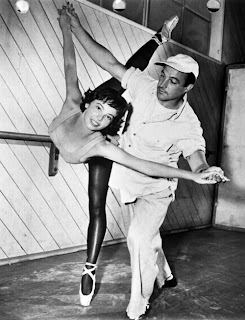 "I started every morning by doing my ballet warm-up, about a half hour alone, as every dancer does before rehearsing or performing. Gene Kelly’s two assistants —Carol Haney, who would later star on Broadway in 'The Pajama Game' and was a remarkable Jack Cole dancer and lovely Jeanne Coyne, freshly divorced from director Stanley Donen and later to become the second Mrs. Gene Kelly— were watching my exercises to give Gene ideas for my introductory solos".
"I started every morning by doing my ballet warm-up, about a half hour alone, as every dancer does before rehearsing or performing. Gene Kelly’s two assistants —Carol Haney, who would later star on Broadway in 'The Pajama Game' and was a remarkable Jack Cole dancer and lovely Jeanne Coyne, freshly divorced from director Stanley Donen and later to become the second Mrs. Gene Kelly— were watching my exercises to give Gene ideas for my introductory solos". "Gene was a great partner, strong, skillful, and with a perfect sense of rhythm. But more than a dancer, he was also smart, a born leader, and liked to take command. He could assess the qualities of his partners and knew how to make the most of them. Gifted with a sense of space on the screen—camera moves held no secrets for him—he was interested in the technical side of camera equipment—lenses and filters, tracking and support equipment".
"Gene was a great partner, strong, skillful, and with a perfect sense of rhythm. But more than a dancer, he was also smart, a born leader, and liked to take command. He could assess the qualities of his partners and knew how to make the most of them. Gifted with a sense of space on the screen—camera moves held no secrets for him—he was interested in the technical side of camera equipment—lenses and filters, tracking and support equipment". "As a choreographer, he was inventive, daring, and more of an athlete than a dancer. Gracefulness wasn’t his thing; you felt he was after strength —a modern man’s physical expression. As a dance director, he was exacting, very much so, but he also had a sense of fair play and would indicate, in measured tones, his approval. His disapproval was sharp, straightforward, and didn’t allow for any excuses".
"As a choreographer, he was inventive, daring, and more of an athlete than a dancer. Gracefulness wasn’t his thing; you felt he was after strength —a modern man’s physical expression. As a dance director, he was exacting, very much so, but he also had a sense of fair play and would indicate, in measured tones, his approval. His disapproval was sharp, straightforward, and didn’t allow for any excuses". "Gene and Betsy Kelly offered the warmth of a few dinners at home, Gene told you to help yourself at the bar, and you did a turn if you felt like performing. Saul Chaplin, our musical director, was at the piano, and everyone knew the words to the songs by Gershwin, Cole Porter, Jerome Kern, Rodgers & Hart or Hammerstein, Irving Berlin. Betsy Blair sang enthusiastically but completely out of tune. It didn’t seem to disturb anyone. Gene did the Irish thing—drink whiskey and talk. Surprisingly enough, Stanley Donen slept soundly on the sofa, undisturbed".
"Gene and Betsy Kelly offered the warmth of a few dinners at home, Gene told you to help yourself at the bar, and you did a turn if you felt like performing. Saul Chaplin, our musical director, was at the piano, and everyone knew the words to the songs by Gershwin, Cole Porter, Jerome Kern, Rodgers & Hart or Hammerstein, Irving Berlin. Betsy Blair sang enthusiastically but completely out of tune. It didn’t seem to disturb anyone. Gene did the Irish thing—drink whiskey and talk. Surprisingly enough, Stanley Donen slept soundly on the sofa, undisturbed". "Judy [Garland] started to sing every song in her repertoire. She sang for several hours, her eyes locked to Vincent’s. No one could foresee that the marriage would soon break up. She sang “The Trolley Song” and “Over the Rainbow,” but I particularly remember her poignant interpretation of “Someone to Watch over Me.”Her voice came straight from the heart. There was in her a feverish intensity; she seemed to be living at a pace that burned her, with her brown eyes wide open, revealing her extreme vulnerability".
"Judy [Garland] started to sing every song in her repertoire. She sang for several hours, her eyes locked to Vincent’s. No one could foresee that the marriage would soon break up. She sang “The Trolley Song” and “Over the Rainbow,” but I particularly remember her poignant interpretation of “Someone to Watch over Me.”Her voice came straight from the heart. There was in her a feverish intensity; she seemed to be living at a pace that burned her, with her brown eyes wide open, revealing her extreme vulnerability". "Gene called me Lester the Pester. He loved me a lot. Gene was my guide" -Leslie Caron in "The Making of An American In Paris" DVD (2008)
"Gene called me Lester the Pester. He loved me a lot. Gene was my guide" -Leslie Caron in "The Making of An American In Paris" DVD (2008)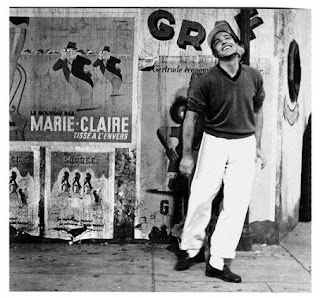 "I can remember Gene forever yelling at me 'Keep your feet straight, bend your knees'. He was a sort of a father figure, a brother figure in my life". -Leslie Caron in "Biography of Gene Kelly, Biography Channel" (1996).
"I can remember Gene forever yelling at me 'Keep your feet straight, bend your knees'. He was a sort of a father figure, a brother figure in my life". -Leslie Caron in "Biography of Gene Kelly, Biography Channel" (1996). "We remained friends ever since. My bond of friendship tightened with the years. Very few girls had the luck to meet their Gene Kelly. Gene was invited to present me with an honor, during a charity gala (1995). Already very ill, he came nevertheless – to whisper a few words in a voice that had lost all its strength. I followed him backstage, where he said : “Only for you Lester.” I was never to see him again". -Leslie Caron in her Foreword to "Gene Kelly, A Celebration" by Sheridan Morley & Ruth Leon (1997)
"We remained friends ever since. My bond of friendship tightened with the years. Very few girls had the luck to meet their Gene Kelly. Gene was invited to present me with an honor, during a charity gala (1995). Already very ill, he came nevertheless – to whisper a few words in a voice that had lost all its strength. I followed him backstage, where he said : “Only for you Lester.” I was never to see him again". -Leslie Caron in her Foreword to "Gene Kelly, A Celebration" by Sheridan Morley & Ruth Leon (1997)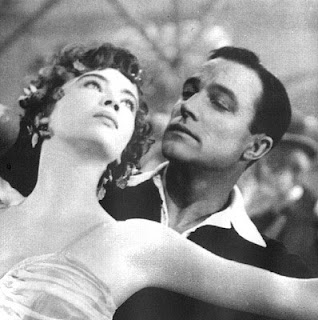 "Gene guided me in front of the camera with patience and good humor. I spoke my first lines phonetically. He would say to me, “Lester, if you want your grandmother to see you in this scene, you had better turn toward the camera when you speak your line.” I wasn’t used to expressing myself with words and definitely not in English; inhibitions were seriously blocking me. I remember the following lines, spoken in the waterfront scene, to Gene, who was already running up the stairway, ten yards away from me: “Jerry! If it means anything to you, I love you!” I was of a deep red hue under my makeup and had broken into a sweat out of fear of being ridiculous".
"Gene guided me in front of the camera with patience and good humor. I spoke my first lines phonetically. He would say to me, “Lester, if you want your grandmother to see you in this scene, you had better turn toward the camera when you speak your line.” I wasn’t used to expressing myself with words and definitely not in English; inhibitions were seriously blocking me. I remember the following lines, spoken in the waterfront scene, to Gene, who was already running up the stairway, ten yards away from me: “Jerry! If it means anything to you, I love you!” I was of a deep red hue under my makeup and had broken into a sweat out of fear of being ridiculous". "For a musical comedy, especially, it was imperative to have the Hays Office certificate of approval. In my introductory number, my solo with a chair was filmed twice because of “censorship difficulties.” A lady with a very plunging neck-line came from the Hays Office to watch rehearsals. She was particularly taken with Gene Kelly’s charm, while he did his wicked best to make her feel welcome. The physical pressure of filming began to tell on me".
"For a musical comedy, especially, it was imperative to have the Hays Office certificate of approval. In my introductory number, my solo with a chair was filmed twice because of “censorship difficulties.” A lady with a very plunging neck-line came from the Hays Office to watch rehearsals. She was particularly taken with Gene Kelly’s charm, while he did his wicked best to make her feel welcome. The physical pressure of filming began to tell on me". "I came down with strange, insidious symptoms—low-grade fever, swollen glands throughout my body (mostly in the groin), unbelievable exhaustion, a feeling of insurmountable lethargy, incapacity to lift my legs, as if they were made of lead. A broken leg is visible, but you can’t see the exhaustion of glandular fever. The studio doctor, Dr. Blank, was called in. He diagnosed mononucleosis. My mother was not sympathetic. 'Vivien Leigh goes on filming with tuberculosis. You can carry on'."
"I came down with strange, insidious symptoms—low-grade fever, swollen glands throughout my body (mostly in the groin), unbelievable exhaustion, a feeling of insurmountable lethargy, incapacity to lift my legs, as if they were made of lead. A broken leg is visible, but you can’t see the exhaustion of glandular fever. The studio doctor, Dr. Blank, was called in. He diagnosed mononucleosis. My mother was not sympathetic. 'Vivien Leigh goes on filming with tuberculosis. You can carry on'." "But Gene Kelly, my protector, arranged for a lighter filming schedule: one day on, one day off. I spent a lot of time in bed. Dr. Blank gave me three shots twice a week—vitamin C, the B vitamins, and iron. Slowly, slowly, the disease left me. The first preview of 'An American in Paris' was considered a disaster—there were sound problems, and work was undertaken immediately afterward to remedy this. The second preview, at the Bay Theatre in Pacific Palisades, was very successful. One hundred and five patrons rated the film “Outstanding!” “One of the best musicals ever,” and so forth. Arthur Freed, Vincente Minnelli, and Gene Kelly had won their bet".
"But Gene Kelly, my protector, arranged for a lighter filming schedule: one day on, one day off. I spent a lot of time in bed. Dr. Blank gave me three shots twice a week—vitamin C, the B vitamins, and iron. Slowly, slowly, the disease left me. The first preview of 'An American in Paris' was considered a disaster—there were sound problems, and work was undertaken immediately afterward to remedy this. The second preview, at the Bay Theatre in Pacific Palisades, was very successful. One hundred and five patrons rated the film “Outstanding!” “One of the best musicals ever,” and so forth. Arthur Freed, Vincente Minnelli, and Gene Kelly had won their bet". Gene asked me how I was feeling. “Gene, I think I caught the flu.” He looked at me and laughed. “Honey, you don’t have the flu. You’ve just seen yourself on the screen for the first time!”
Gene asked me how I was feeling. “Gene, I think I caught the flu.” He looked at me and laughed. “Honey, you don’t have the flu. You’ve just seen yourself on the screen for the first time!” Debbie Reynolds and Gene Kelly in "Singin' in the Rain" (1952)
Debbie Reynolds and Gene Kelly in "Singin' in the Rain" (1952)"Debbie Reynolds, had achieved a nice success with a song that the radio stations played in a loop, “Aba-Daba Honeymoon.” With the royalties Debbie ordered a swimming pool for the backyard of her family’s house in Burbank. Somehow Jack Larson and I were both invited to the poolwarming barbecue, and a long friendship ensued, still close to this day".
The Making of "An American in Paris" - "Thank Heaven: A Memoir" by Leslie Caron (2010)



















